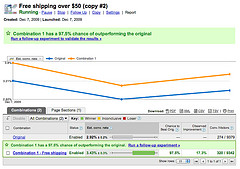
If you manage PPC campaigns appropriately, then you undoubtedly conduct a lot of tests. Many of these tests probably fail.
One of the most important elements of conducting tests – especially ineffective tests – is communication. You need to make sure that all stake holders understand what was tested; why the test wasn’t successful; most importantly – what was learned.
Testing within the realm of PPC can include launching new keywords, restructuring campaigns and ad groups, trying new or extreme ad messaging, landing page optimization, or experimenting with new tools such as conversion optimizer (CPA bidding) or Google Display Optimizer.
Every new account, every adgroup, every keyword, every ad is a test. There are no guarantees when you start – which keywords will work, which ads, which search networks, and so on. Everything’s a test in the beginning. And no matter how long your account has been running, the way to improvement is always to keep testing- keep what works, throw out what doesn’t, and try to learn from that in the process.
Some of the big mistakes people make in PPC in regards to testing are:
- Not testing at all
- Not having conversion tracking in place so you can measure test results by the right metric
- Running too many tests for your budget
- Running too many tests and lowering account performance
- Not padding tests to reduce the risk of performance decreases
Why test PPC?
1. You’re paying for this traffic. Pages that don’t convert are sucking money on a constant basis. For competitive keywords (high search volume, high competition, high click through and high cost-per-click) the cost can be astronomical.
2. You can predict purchase intent by referring keyword. (This is not possible in Google Website Optimizers and some other testing platforms). When you can control for what the purchase intent is (e.g. “accounting software for small business” vs “accounting software for non-profit”), you can better craft messaging. Both searches may point to the same product, but the highlighted features, headline, messaging and testimonials can all be laser-targeted to the end-user.
3. You can optimize for the medium. Paid search lands directly on the product or offer page, which means the visitor has not navigated through your site and may not be familiar with your value proposition, offering, etc. You can apply the learnings you’ve gleaned from web analytics about paid search vs. rest of site traffic to these pages (use your Advanced Segments in Google Analytics or other platform).
4. When you optimize for the most popular product pages, you’ll drive more traffic to your checkout (and your checkout test, which may speed test completion there as well).
5. You can run unlimited tests concurrently (I’ve said it once before but it bears repeating). Plus, your learnings may be applicable to the rest of your site (e.g. headline A converts better than headline B across a number of tested keywords). This is efficient!
Resource Articles for PPC Testing:
How to Recover from a PPC Test That Crashed & Burned – Search Engine Watch (#SEW)
The 5 Biggest Mistakes in PPC Testing | Search Engine Journal
Why You Should Test PPC Landing Pages First | Get Elastic Ecommerce Blog






























